|
In the days when only the outbreak of a World War could stretch newspaper headlines across more than one column - and then only in mild terms. Horatio Bottomley kept his weekly paper going by an unbroken succession of (by the standards of his day) sensational headlines such as the sample above. If it wasnt a fake it was a hoax or a fraud or a swindle. Whether what one learnt on buying the paper justified the titles I never found out, because (having inherited a canny Aberdonian outlook) I suspected it didnt. Come to think of it, my headline is really unnecessary, it being well known that of all Wireless World readers the audio section are the most fanatical, and to them the word 'stereo' is the most emotive, so that if merely printed by itself in very small type it would compel all of them at least to begin to read, before disagreeing. Come to think of it again, my headline is probably unwise, too. Horatio Bottomley ended up in jail.
But I was driven to it by attending the IEE Convention on Stereophony, my outstanding conclusion from which was that any connection between the admitted benefits of stereophony and the techniques currently employed therein was largely coincidental. In so far as these techniques - the two channels, spaced loudspeakers, etc. - seem to the superficial observer to imply a fairly exact science, the word 'fake' is perhaps not too far-fetched. However (though I wouldnt accept a brief for the salesman-demonstrator) I dont want to suggest that the designers of such equipment are men of guile. It is from them, chiefly, that one learns how empirical the whole thing is.
To begin with, in spite of the vast amount of research that has been carried out on hearing, that sense is still very far from being completely understood. Accustomed though we now are to the fabulous exploits of electronic computers, the continuous almost instantaneous analysis of data in the form of minute fluctuations in air pressure at each side of the head, and their presentation in terms that can control the actions of the most clueless clot as well as ravish the soul of the most cultured musician, makes the said computers look pretty clumsy.
Brain Judges Directions
One aspect of this complicated business of hearing is the ability to locate sources of sound. After a lot of argument, it seems now to be generally agreed that the time difference of arrival of sound at the two ears is the main basis for aural direction-finding. But it is also agreed that three or four other things come into it, and that the brain (without any course of scientific training) makes the best use of all the available data, and in favourable circumstances can judge directions correctly to within about one degree. If the source is exactly straight in front or behind, the sound reaches both ears simultaneously. Now if you calculate the time difference when the source is shifted one degree, assuming your ears are 8 inches apart and that sound travels at 1,100 ft / sec, you will find it is about 0.00001 sec, or 10 micro-seconds. In some way or other, it seems, we can detect such minute time differences and interpret them as angular differences.
But, of course, only the very naive think of stereo-phonic reproduction chiefly as a means of locating and following sources of sound - trains going through stations, or even Wagnerian villains moving in on helpless heroines. Much more important is the restoring of what is lost in 'hole-in-the-wall' monodic (monaural or monophonic) reproduction - the quality rather vaguely described as spatial effect.
Before considering it, one might think that in direct listening this effect was due mainly to being able to locate the source or sources of sound. So much so that many months ago a correspondent! asserted that such items as piano music and songs had nothing to gain from stereophonic reproduction, nor even orchestral music, the ideal for which was a perfect blending of the separate sounds into a Single unified sound. If a singer was standing or a speaker sitting in a perfectly anechoic (acoustically dead) studio, and was being reproduced monodically in a listening room of suitable acoustical characteristics, then certainly it would be difficult to see how stereophony could help. But anyone with normal hearing and appreciation who has had the opportunity to compare the two kinds of reproduction of an orchestra could hardly fail to be struck by the improvement with stereophony.
Sensational Evidence
The nature of this improvement is difficult to describe, and the attempts of salesmen to describe it in terms favourable to their commission accounts may only have tended to prejudice it adversely in the minds of you discriminating and ungullible readers. But that such a (if he will forgive me) hard-headed north-countryman as James Moir - waxed as enthusiastic as he did in the issue of November 1956 may well have shaken even the most sceptical. In particular, he gave one factual piece of information beside which all the eulogies of all the worlds advertising copywriters pale into insignificance - that three ladies sat for more than an hour listening to opera in Italian and music by Prokofiev and Sibelius without saying a single word to each other except in the intervals. I - and I can hardly imagine any dissentient - can reinforce his testimony that in a very long experience this has never been known to happen before. The information that these ladies did speak to one another in the intervals, is of course, of vital significance; without it one would naturally assume that Mr Moir was charitably entertaining a group of dumb patients.
The nature of this improvement, as I said, is difficult to describe, and without some investigation might perhaps not be expressible more definitely than by saying that stereophonic reproduction is easier to listen to. One can have the music at somewhere near full natural sound intensity without feeling - as I invariably do during monodic demonstrations - that it is uncomfortably loud. There is a sense of 'space' which one does not get merely by having several paralleled speakers about the room, and the instruments 'stand out' more clearly. This last, by the way, is not bound up so directly as one might think with aurual direction-finding. Listening to such reproduction, I for one am not particularly conscious of this instrument being situated on the left, and that one in the middle; in fact even when I try I often find it difficult to locate them and tend to fall back on knowledge of the customary placing of such instruments in an orchestra.
Nobody, I imagine, would expect two-channel stereophonic reproduction by loudspeaker to be theoretically perfect, even though theory does lead one to expect (and listening confirms) that the apparent direction of a sound can be reproduced with fair accuracy anywhere within the angle subtended by the two speakers - and perhaps even a little beyond. But anyone who hasnt studied the thing and has only a vague idea that the two channels are supposed to correspond with our two ears, and may even have heard that the microphones are sometimes placed at each side of a dummy head, may feel no great surprise that stereophonic reproduction seems - and probably is - a much closer approximation to the real thing than monodic. If any readers are in that state, my purpose is to try to awaken or increase their surprise.
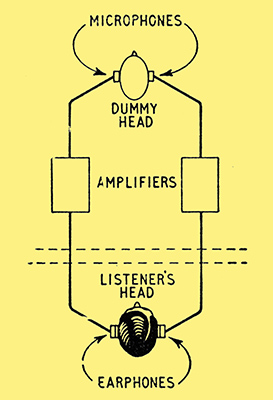
Fig. 1. A true binaural sound transmission system (provided the dummy moves his head in synchronism with the listener).
Before discussing the usual loudspeaker method, for the sake of comparison let us look at the headphone method. Fig. 1 shows the minimum requirements; the microphones and earphones could, of course, be linked by broadcasting channels. Given perfect apparatus, this system should give perfect binaural hearing - with one important exception, often forgotten. A listener to sounds coming from different directions, especially if their sources are moving, is not content to keep his head rigidly fixed in one position. He moves it; perhaps only slightly, but we have already calculated that one degree (corresponding to one-seventh of an inch path difference) is significant. Head movement is necessary for direction-finding, and especially for resolving the ambiguity when the source is exactly ahead or astern. If this listener moves his head his purpose is frustrated unless the dummy moves its head in exactly the same way. Such a refinement, presumably by means of Selsyns (servo motors-Ed.) attached to the two heads and interconnected, would add considerably to the cost and inconvenience. Without it, whenever the listener moves his head the whole of the room in which the dummy is located appears to move with it - a rather disconcerting effect. How-ever, one feature that should particularly be noted is that this kind of stereophony is effective over the full azimuth of 360°.
Suppose next that this system remains the same at the microphone end, the dummy being placed in the most desirable seat for the particular kind of performance, and for convenience the earphones are replaced by loudspeakers. Where should they be placed?
This moment might, with more justification than in some television programmes, be deemed to be a natural break; not for being switched abruptly from deep tragedy to frivolous sales promotion for alternatively a 'cuppa', but for deep thought. Remember that the main object of using loudspeakers is to enable more than one person to listen. So its not much use suggesting putting them equidistantly on each side of the listeners head. Even if they were so placed, the fundamental difficulty about loudspeakers would remain - each would be heard by both ears. So the scientific each-ear-its-own-channel basis of Fig. 1 goes by the board. Such a fundamental failing would, of course, lead the theorist to abandon the project forthwith, leaving the field clear for those who do what all well-informed persons know is impossible.
Let us then see how loudspeakers one on each side could be expected to work, still with the microphones on the dummy head, and assuming at first that all listeners are compelled to sit (or stand, if they prefer) at equal distances from the speakers (Fig. 2).
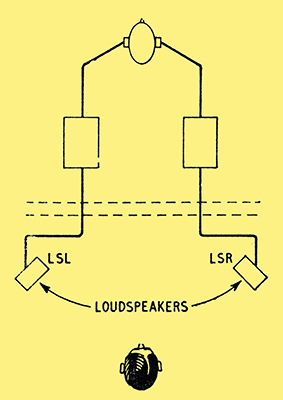
Fig. 2. The same as Fig. 1 at the pick-up end, but earphones replaced by loudspeakers at the receiving end. This entirely alters the listening conditions.
A sound coming from straight ahead of the dummy would affect both microphones simultaneously and equally, and (assuming exactly similar channels throughout and loudspeakers connected in phase) the speakers would reproduce in unison, as if they were connected in parallel. The sound from LSL reaches the listeners left ear just as the same sound from LSR reaches his right ear. If both speakers are inclined at 45° with reference to the listener, the same sounds reach his opposite ears 430 microseconds or 0.43 millisecond later.
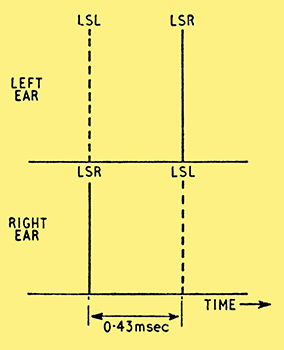
Fig. 3. In this and the following diagrams the amplitude of sound reaching the two ears from the left-hand loudspeaker is represented by the height of the dotted lines; that from the right-hand speaker by full lines. The relative times of arrival are indicated by horizontal spacing. This diagram refers to Fig. 2, with a sound coming from straight in front of the dummy.
These conditions can be represented as in Fig. 3, where sound from LSL is represented by a dotted line and sound from LSR by a full line; not that the 'programme' consists necessarily of a single sharp pulse, but the line marks any one phase of a sound. The higher its frequency, the more the sound reaching the farther ear is screened by the listeners head, but at fairly low frequencies this effect can be neglected, as I have done here so as not to confuse the issue by introducing one of the subsidiary influences in aural sound location.
If the source of sound had been straight ahead of the listener, reproducing the circumstances of the dummy, Fig. 3 would have had only one simultaneous pair of verticals.
What impression would we expect this arrival of the same sound from widely differing directions to make? Since the sounds represented in Fig. 3 by dotted and full lines are identical, the first impact should be the same as if it were being received from one speaker at the same distance as the two, but straight ahead. The second impact could be due to a second speaker also straight ahead but 8/√2 = 5⅔in beyond it. So one would expect the apparent source to be straight ahead. And if you try it you will find it to be so. Thus far, then, the system is doing its job.
But you may be a trifle worried by the thought that as little as one seventh of an inch inequality in the listeners distances from the two speakers results in a time difference sufficient to be interpreted as an angular deviation from the centre of about 1°. I dont know what the experts say, but I certainly cant judge the apparent source to within 1°; however, a shift of the order of 10° is perceptible on moving the head a very short distance sideways, possibly as little as is sufficient to cause 1.4 (ten sevenths) in difference. In these circumstances Fig. 3 gives place to Fig. 4.
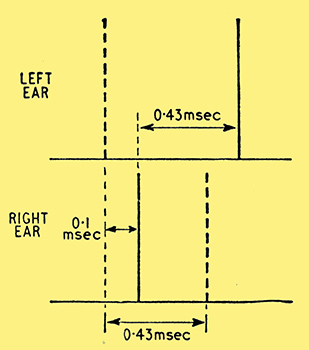
Fig. 4. Here, the sound is coming from a source 10° to the left of straight ahead of the dummy.
Here, the first impacts on the ears correspond to what one would get from a single source 10° to the left. But the second impacts mimic a source 10° to the right! Apparently, however, only the first impacts are significant.
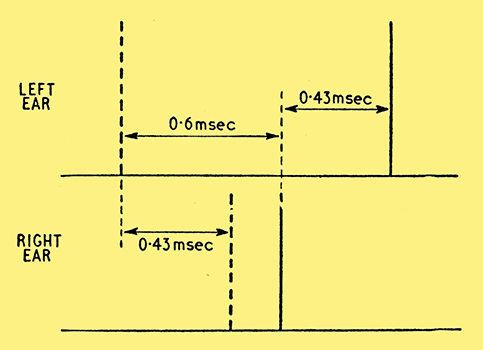
Fig. 5. The angle of sound direction to the left is here increased to 90° straight into the dummys left 'ear'.
Further sideways movement shifts the apparent source, as one would expect, to the nearer speaker. But, contrary to what one might expect, it remains there no matter how much nearer one is to it than to the other. In the October, 1957, issue (p. 479) Mr Moir explained this as an example of the Haas effect, which is the name given to the fact that when the same sounds reach a listener from more than one direction with a time difference of more more than very little about microphones and loud-speakers the thought will immediately occur that it is one thing to prescribe that their directional characteristics must be such and such, and a very different matter to make them so - at all audio frequencies. This technical difficulty no doubt accounts for much of the shortcoming of actual stereo results.
But before going on to that you may find it necessary to convince yourself (as I did) that amplitude differences are going to do what is wanted. This can only be done properly by quite a bit of trigonometry, which is given in proper treatments of the subject; but let us see what our simple diagrams show.
When the sound comes from the direction which can be described as straight ahead of the microphone site, both microphones pick it up equally, so Fig. 3 again serves to represent the result. The listener (assumed for the moment to be on the centre line) hears it from his straight-ahead position, midway between the speakers.
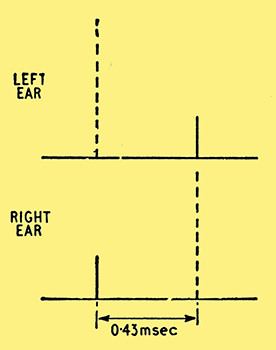
Fig. 6. Here again the sound is coming from left of straight ahead, but the microphones are placed together and are directional so that one receives more strongly from sounds to the left and the other from sounds to the right.
A sound coming from the left gives a stronger output from LSL than LSR, so the diagram is as Fig. 6. One might guess that this would make the sound appear to come from the left, but it is by no means obvious that the angle of leftwardness could be made equal to that of the original source by suitable microphone directional characteristics, as usually expressed in polar diagrams. It can be shown better by a vector diagram, Fig. 7, on the assumption of course that the sound has a sine waveform.
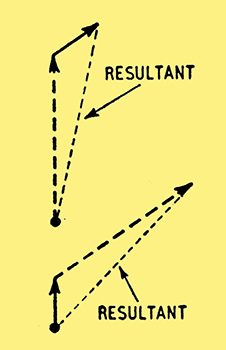
Fig. 7. This vector diagram shows more clearly than Fig. 6 that differences in amplitude of sounds coming from different directions with phase displacements affect their resultant phase. In this example the sound would apparently reach the left ear in advance of the right.
Here the amplitudes from LSL and LSR are represented as before by the lengths of dotted and full lines respectively, but the time delay shown in the previous diagrams by a horizontal displacement to the right are here shown as an angular displacement clockwise. The amount of angle for a given time depends of course on the frequency of the sound, and in this case is assumed to be 45°. If the sounds from both speakers were equal in amplitude, the two vectors for each ear would add up to give resultants in phase with one another, but this example of unequal amplitudes shows a resultant phase difference. This means a certain time difference between the sound at the two ears, interpreted by the listener as a leftward source of sound. The greater the difference in amplitude, the greater the phase difference and the greater the apparent leftward angle of the source. Of course if the amplitude from LSR is the greater, the angle will be rightward.
If the original source is straight ahead, this system obviously is the same as the other one in so far as movement of the listener to one side shifts the apparent source of sound in the same direction. It can be shown (Im not pretending to be giving an exhaustive treatise) that when the source is off-centre its apparent direction also depends on the position of the listener. One has only to draw the vector equivalent of Fig. 4 with unequal amplitudes to see that. Now that we know that time (or phase) and amplitude differences are (for stereophonic purposes) equivalent, we can deduce that the time advance as regards LSL when the listener moves to the left can be compensated by a reduction in loudness from LSL as compared with LSR. As I said, it is one thing to call for loudspeakers having the directional characteristics needed to achieve this compensation at all frequencies, and in the present state of the art quite an impossible thing to get them. Which is why what one hears from different positions even within a defined stereophonic listening area is usually strikingly different. And remember we have considered only one of several kinds of data used in aural direction-finding, and have ignored indirect sound and reverberation. But, again as I said, one can get a very marked improvement on monodic reproduction even when the two-channel system yields far from theoretically perfect stereophony. Why worry how it is faked so long as it sounds good?
|